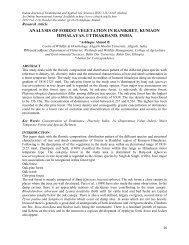epidemiology-clinical profile of cleft lip and palate among ... - CIBTech
epidemiology-clinical profile of cleft lip and palate among ... - CIBTech
epidemiology-clinical profile of cleft lip and palate among ... - CIBTech
You also want an ePaper? Increase the reach of your titles
YUMPU automatically turns print PDFs into web optimized ePapers that Google loves.
<strong>CIBTech</strong> Journal <strong>of</strong> Surgery ISSN: 2319-3875 (Online)An Online International Journal Available at http://www.cibtech.org/cjs.htm2013 Vol. 2 (1) January-April, pp.45-51/Banerjee <strong>and</strong> DhakarReview ArticleAs per America Cleft Palate-Crani<strong>of</strong>acial Association special team includes-reconstructive surgeon,otolaryngologist, plastic surgeon, oral maxill<strong>of</strong>acial surgeon, speech-language pathologist, orthodontist,paediatric or prosthodontics, dentist developmental or general paediatrician genetics counselloraudiologist nurse social worker psychologist. To achieve best results one should ensure that theappropriate interventions are carried out at the appropriate time to in achieving functional <strong>and</strong> aestheticresults (Table 2).Surgical ConsiderationTime to perform surgeries varies <strong>among</strong> surgeons. Surgeon perform <strong>lip</strong> repair within 48 hours <strong>of</strong> thechild’s birth in institutional delivery case to ensure utilization <strong>of</strong> hospital stay <strong>and</strong> facility as well asreduce stigma in society by allowing parents to leave the hospital with a healthy-appearing new-born.While some surgeon prefer surgery to allow for more tissue availability for the repair, thus providingmore time for parent-child bonding, <strong>and</strong> more time for the parents to gain a better underst<strong>and</strong>ing <strong>and</strong>acceptance <strong>of</strong> the infant’s congenital deformity (Show et al., 2002) . Most popular in CL/P surgery is the“RULE OF 10S” applied surgery which is consider best time to perform surgical intervention - infant is atleast 10 weeks old, weighs 10 pounds, <strong>and</strong> has a haemoglobin level <strong>of</strong> 10 g/dL, thereby surgeries areperformed during the child’s second to third month <strong>of</strong> life for health wellbeing <strong>among</strong> children (Tolorovoet al., 1971).Various surgical techniques use as-Unilateral <strong>and</strong> bilateral <strong>lip</strong> Repair, Milliard Technique is used in whichsurgical procedure like advancement flap, rotation advancement flap <strong>and</strong> rotation flap. For <strong>cleft</strong> <strong>palate</strong>repair (palatoplasty) basic surgical techniques include primary veloplasty (Schweckendiekpalatoplasty),bipedicled flap palatoplasty (von Langenbeck), V-Y pushback palatoplasty, unipedicled two-flappalatoplasty, <strong>and</strong> the double-opposing Z-plasty (Furlow) palatoplasty (Tolorovo et al., 1998).CONCLUSIONCleft <strong>lip</strong> <strong>and</strong> <strong>palate</strong> is congenital birth deformity which needs to be treated at time <strong>and</strong> right age. It hascomplex approach <strong>and</strong> need team <strong>of</strong> expertise to provide better development <strong>and</strong> functional efficacy.Global burden vary as per geographic location, race, ethnicity, genetic factors, maternal health, drug use<strong>and</strong> environmental factor associated with it. In India lack reporting <strong>of</strong> congenital deformities due to lack<strong>of</strong> access to health care, awareness, social stigma, poverty, literacy thus true incidence <strong>and</strong> prevalence <strong>of</strong>cases not available. Need for National registry <strong>of</strong> birth defects is necessary state wise as well asconsidering vast diversity <strong>of</strong> ethnicity. Though India has initiative to take up more research in to addressthe etiology <strong>and</strong> care <strong>of</strong> or<strong>of</strong>acial <strong>cleft</strong> <strong>and</strong> planned proper multidisciplinary approach to tackle thisproblem. WHO have also made collaborative initiative with 6 Asian countries <strong>among</strong> this countries Indiathrough National research body like Indian Council <strong>of</strong> medical research have made initiative to providemore data base in genetic disorders <strong>and</strong> birth defects <strong>among</strong> population are focused <strong>and</strong> intensiverecording through NHFS team in India. Presently there is need to aware <strong>and</strong> educate Indian peopleregarding slow <strong>and</strong> steady increase in genetic <strong>and</strong> congenital birth defects <strong>and</strong> National approach to dealwith congenital birth defects should be provided in government health care centers.ACKNOWLEDGEMENTWe are thankful to Manipal University Library “Health Science” for providing best search system <strong>and</strong>conducting awareness program <strong>and</strong> encouraging us in doing authentic search <strong>of</strong> indexed articles from database <strong>of</strong> UpToDate, Muportal, Proquest etc. We pay our gratitude to library staffs for providing us withfull support <strong>and</strong> helping us with books <strong>and</strong> journal search.REFERENCESHaug LW, Levine D, Firth VH <strong>and</strong> Barss AV [No date]. Etiology, prenatal diagnosis, obstetricalmanagement, <strong>and</strong> recurrence <strong>of</strong> or<strong>of</strong>acial <strong>cleft</strong>s. Sep 4, 2012. Available: www.uptodate.com [Accessed 24April 2013].50
















